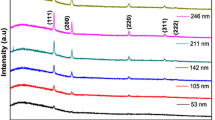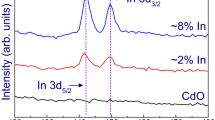Abstract
Precursor sols of cadmium-doped indium oxide system with different dopant concentrations (In:Cd = 99:1–90:10) have been prepared from the corresponding metal salt solutions in alcoholic medium. Films are deposited on glass by sol–gel dipping process. The XRD study of the air cured films reveals formation of both bixbyite phase of indium oxide and cubic phase of cadmium oxide. From the FESEM analysis of film surface, line defects are identified for low dopant concentration. Particle size of the film materials processed under differential partial pressures of oxygen gas is determined. The TEM image of the lowest dopant concentration (In:Cd = 99:1) sample exhibits cluster dimension ~24 nm. HRTEM identifies the formation of screw dislocations. Sheet resistance was recorded as 800–1000 kΩ/□ for the lowest dopant concentration (In:Cd = 99:1). Evidence for highly transparent feebly conducting films is produced. On Cd doping, formation of interstitial solid solution instead of substitutional solid solution has been predicted. Band gap of the doped system has been evaluated from their absorption spectra. Photoluminescence study explores major oxide defects in the film material.
Graphical Abstract
Magnified view of HRTEM image of ICO-1 particles cured at 500 °C for 1 h. in air showing distorted lattice lines, a screw dislocation (marked arrow head).













Similar content being viewed by others
References
Beena D, Vinodkumar R, Navas I, Rajan G, Pillai VPM (2010) Efficient photoluminescence from pulsed laser ablated nanostructured indium oxide films. Mater Sci Eng B 174(1):59–65
Gordon RG (2000) Criteria for choosing transparent conductors. MRS Bull 25:52–57
Kundu S, Biswas PK (2005) Synthesis and photoluminescence property of nanostructured sol–gel indium tin oxide film on glass. Chem Phys Lett 414(1–3):107–110
Choisnet J, Bizo L, Retoux R, Raveau B (2004) Antimony and antimony–tin doped indium oxide, IAO and IATO: promising transparent conductors. Solid State Sci 6(10):1121–1123
Liang Y-C (2010) Surface morphology and conductivity of zirconium-doped nanostructured indium oxide films with various crystallographic features. Ceram Int 36(5):1743–1747
Winter R, Scharnagl K, Fuchs A, Doll T, Eisele I (2000) Molecular beam evaporation-grown indium oxide and indium aluminium films for low-temperature gas sensors. Sens Actuators B 66(1–3):85–87
Glot AB, Mazurik SV, Jones BJ, Bondarchuk AN, Bulpett R, Verma N (2010) Current limiting and negative differential resistance in indium oxide based ceramics. J Eur Ceram Soc 30(2):539–544
Wang A, Babcock JR, Edleman NL, Metz AW, Lane MA, Asahi R, Dravid VP, Kannewurf CR, Freeman AJ, Marks TJ (2001) Indium-cadmium-oxide films having exceptional electrical conductivity and optical transparency: clues for optimizing transparent conductors. PNAS 98(13):7113–7116
Ali HM, Mohamed HA, Wakkad MM, Hasaneen MF (2007) Properties of transparent conducting oxides formed from CdO alloyed with In2O3. Thin Solid Films 515(5):3024–3029
Flores MA, Castanedo R, Torres G, Zelaya O (2009) Optical, electrical and structural properties of indium-doped cadmium oxide films obtained by the sol–gel technique. Sol Energy Mater Sol Cells 93(1):28–32
Lee SH, Lee JH, Kim KH (1989) Electrical properties of pure and cadmium-doped indium sesquioxide. Bull Korean Chem Soc 10(7):418–422
Rejitha SG, Krishnanb C (2013) Synthesis of cadmium-doped copper oxide nanoparticles: optical and structural characterizations. Appl Sci Res 4(2):103–109
Zhang X, Yang H (2012) Structural characterization and gas sensing property of Cd-doped SnO2 nanocrystallites synthesized by mechanochemical reaction. Sens Actuators B Chem 173:127–132
Choi JS, Kang YH, Kim KH (1977) Electrical conductivity of cadmium oxide. J Phys Chem 81:2208–2211
De A, Biswas PK, Manara J (2007) Study of annealing time on sol–gel indium tin oxide films on glass. Mater Charact 58(7):629–636
Biswas PK, De A, Pramanik NC, Chakraborty PK, Ortner K, Hock V, Korder S (2003) Effects of tin on IR reflectivity, thermal emissivity, Hall mobility and plasma wavelength of sol–gel indium tin oxide films on glass. Mater Lett 57:2326–2332
Neubert T, Neumann F, Schiffmann K, Willich P, Hangleiter A (2006) Investigations on oxygen diffusion in annealing processes of non-stoichiometric amorphous indium tin oxide thin films. Thin Solid Films 513(1–2):319–324
Sakka S (1989) Sol-gel science and technology. World Scientific, Singapore, p 346
Dislich H (1988) Sol-gel technology for thin films, fibres, preform, electronics and specialty shapes. Noyes Publications, New Jersey, p 50
Klein LC (1994) Sol-gel optics: processing and applications. Kluwer Academic Publishers, Boston
Nitta SV, Jain A, Wayner PC Jr, Gill WN, Plawsky JL (2010) Effect of sol rheology on the uniformity of spin-on silica xerogel films. J Appl Phys 86(10):5870–5878
Sheridan F (1995) Characterisation and optimisation of sol–gel derived thin films for use in optical sensing. Dublin City University, Submitted for the Degree of Master of Science
Cotter R (1969) Ring forming polymerization carbocyclic and metallorganic rings. Academic Press, London
Li C, Zhang D, Han S, Liu X, Tang T, Lei B, Liu Z, Ann CZ (2003) Synthesis, electronic properties, and applications of indium oxide nanowires. N Y Acad Sci 1006:104–121
Ghosh SS, Neogi S, Biswas PK (2014) Microstructural and optical characterizations of sol–gel based nanoclustered indium (III) doped cadmium(II) oxide films on glass. Mater Res Express 1(045201):1–7
Paria MK, Maiti HS (1983) Electrical conductivity of polycrystalline tin dioxide and its solid solution with ZnO. J Mater Sci 18(7):2101–2107
Thomas CI, Kuang X, Deng Z, Niu H, Claridge JB, Rosseinsky MJ (2010) Phase stability control of interstitial oxide ion conductivity in the La1+xSr1−x Ga3O7+x/2 melilite family. Chem Mater 22(8):2510–2516
Das N, Jana S, Biswas PK (2013) Sol–gel foam based Cr(III)–Sn(IV) doped indium oxide:characterizations of morphological, structural and magnetic properties. RSC Adv 3(30):12164–12175
Raynor GV (1949) The lattice spacings of substitutional solid solutions. Trans Faraday Soc 45:698–708
Taira H, Shima H (2014) Optical conductivity of semiconductor crystals with a screw dislocation. Solid State Commun 177:61–64
Chen Q, Braun A, Yoon S, Bagdassarov N, Graule T (2011) Effect of lattice volume and compressive strain on the conductivity of BaCeY-oxide ceramic proton conductors. J Eur Ceram Soc 31(14):2657–2661
Hamberg I, Granqvist CG (1986) Evaporated Sn-doped In2O3 films: basic optical properties and applications to energy–efficient windows. J Appl Phys 60:R123–R159
Choi JS, Kang YH, Kim KH (1977) Electrical conductivity of cadmium oxide. J Phys Chem 81(23):2208–2211
Tauc J (1974) Amorphous and liquid semiconductors. Plenum, London, p 159
Wei SH, Segev D (2005) Electronic and optical properties of spinel TCOs: SnZn2O4, SnCd2O4, and CdIn2O4 Conference Paper, NREL/CP-520-37008, pp 1–2
Ali HM, Mohamed HA, Wakkad MM, Hasaneen MF (2007) Properties of transparent conducting oxides formed from CdO alloyed with In2O3. Thin Solid Films 515:3024–3029
Naje AN (2013) Optical characteristics of CdO nanostructure. Phys Rev Res Int 3(4):372–478
Flores-Mendoza MA, Castanedo-Perez R, Torres-Delgado G, Toma SA, Mendoza-Alvarez JG, Zelaya-Angel O (2010) Low-temperature photoluminescence spectra of CdO–In2O3 thin films prepared by sol–gel. J Lumin 130:2500–2504
Zaien M, Hmood A, Ahmed NM, Hassan Z (2013) Growth and characterization of different structured CdO using a vapor transport. Mater Lett 102–103:12–14
Dua L, Biswas PK (2013) Synthesis and photoluminescence property of nanostructured sol–gel antimony tin oxide film on silica glass. Chem Phys Lett 572:66–72
Acknowledgments
Authors acknowledge the Director of CSIR-CGRI for providing instrumental facilities for the preparation of films and some characterizations. Authors also acknowledge Dr. Laxmikanta Dua, Salkia Hindu High School, Unit-2, Howrah, WB for sharing his knowledge on the photoluminescence properties of semiconductor films. One of the authors (SSG) gives special thanks to CSIR-HRDG for offering him fellowship (CSIR-SRF).
Author information
Authors and Affiliations
Corresponding author
Additional information
Major work was executed at CSIR-CGCRI, Kolkata-700032, India in collaboration with the School of Energy Studies, Jadavpur University, Kolkata-700032, India.
Rights and permissions
About this article
Cite this article
Ghosh, S.S., Neogi, S. & Biswas, P.K. Sol–gel based Cd(II)-doped In2O3 transparent conducting thin film on glass. J Sol-Gel Sci Technol 78, 195–206 (2016). https://doi.org/10.1007/s10971-015-3936-5
Received:
Accepted:
Published:
Issue Date:
DOI: https://doi.org/10.1007/s10971-015-3936-5




